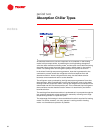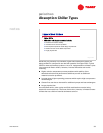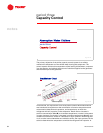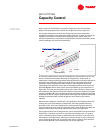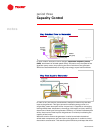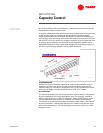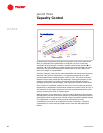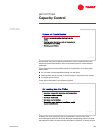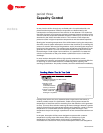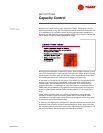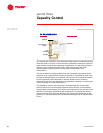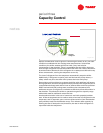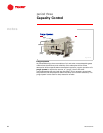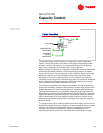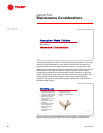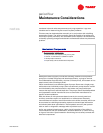
40 TRG-TRC011-EN
notes
period three
Capacity Control
its way into the chiller through any available path. As explained earlier, the
pressure and temperature inside the evaporator are determined by the
concentration and temperature of the solution in the absorber. If air leaks into
the chiller, however, the evaporator pressure increases because a portion of the
volume inside the evaporator–absorber sections is taken up by air, which is not
absorbed by the lithium bromide solution. This increase in the evaporator
pressure results in higher evaporator temperatures and decreased capacities.
Sensing the increasing temperature of the chilled water leaving the evaporator,
the chiller control system attempts to overcome the condition by increasing the
amount of solution delivered to the generator and by increasing the amount of
heat input to the generator. This causes more refrigerant to be boiled off in the
generator and results in a more concentrated solution being delivered to the
heat exchanger. Under higher load conditions, it is possible to increase this
solution concentration to the point where crystallization occurs in the heat
exchanger.
In most modern absorption chillers, high-quality construction, smart
microelectronic controls, and automatic purge systems are extremely effective
in removing air from inside the chiller, maintaining chiller capacity, and
avoiding crystallization. Any leaks, however, should be addressed immediately.
Cooling water that is too cold, combined with a high load on the chiller, is
another possible cause of crystallization. Colder cooling water causes the
temperature of the dilute solution travelling from the absorber to the generator
to drop. This cool dilute solution entering the heat exchanger absorbs a greater
amount of heat from the concentrated solution and, therefore, results in a lower
temperature of concentrated solution leaving the heat exchanger. If the
temperature drops low enough, crystallization of the concentrated solution can
occur.
In the past, absorption chillers were designed to operate with constant-
temperature cooling water. With these chillers, a sudden drop in the
temperature of the cooling water could result in crystallization. The
microelectronic controls for many modern absorption chillers are designed to
▲
◆ Decreases temperature of dilute solution
traveling to generator
◆ Results in lower
temperature of
concentrated solution
returning to absorber
◆ Causes concentrated
solution inside heat
exchanger to crystallize
Figure 48



